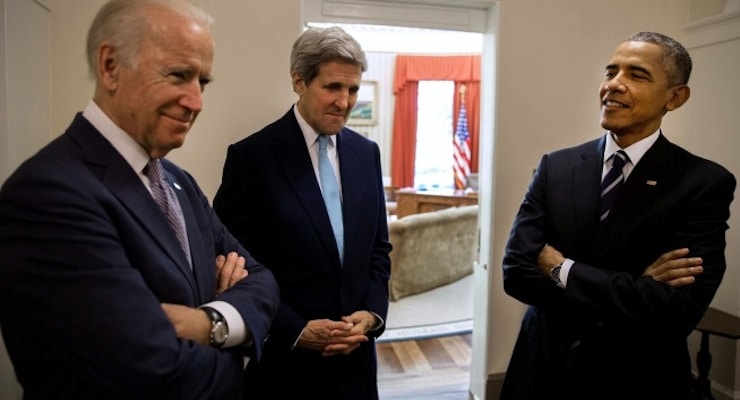

President Barack Obama talks with Vice President Joe Biden and Secretary of State John Kerry in the hallway outside the Oval Office prior to entering the Roosevelt Room to announce the administration’s rejection of the Keystone XL pipeline, Nov. 6, 2015. (Official White House Photo by Pete Souza)
The Obama administration has finally passed judgment on the Keystone XL pipeline, and it’s a thumbs-down. The environmental arguments against it have always been impeccable. But it took America’s turn toward energy independence to cut down the economic case for it.
Americans still need oil, but we can choose to reject the dirtiest kind. A 1,179-mile pipeline was to carry crude from the tar sands in Alberta to a pumping station in Nebraska, with a separate expansion to the Gulf Coast. Tar sands oil generates 17 percent more planet-warming gases than conventional oil.
In the days of heavy reliance on Mideast oil, opposing any dependable new source of oil, above all from friendly Canada, posed political risk. But boy, have things changed. New technologies have enabled us to get at large stores of domestic oil and gas. And we’re developing ways to harvest clean energy.
Texas has so much wind power now that some utilities are giving away electricity at night. Why on earth should the U.S. be enabling the transport of tar sands gook from the bottom of the environmental oil barrel?
With the price of oil way down and little public wailing about prices at the pump, Obama was able to say “no” to the pipeline without facing serious political blowback.
Not even from Canada, where most politicians felt duty-bound to back the pipeline. That included the new prime minister, Liberal Party leader Justin Trudeau. Though Trudeau’s heart wasn’t much in it, Obama’s decision to nix the project took some heat off him.
There’s no little irony in the fact that the project was ultimately stopped by people who generally don’t care about global warming. We are speaking of Nebraskans.
A major oil spill would have threatened the massive underground Ogallala aquifer, which supplies water to Nebraska’s ecologically fragile Sandhills and well beyond. The aquifer is what makes this region agriculturally rich, as opposed to the Great American Desert early travelers once thought it was.
A pipe moving 830,000 barrels of oil a day would be no small concern. And the 2010 Deepwater Horizon disaster in the Gulf of Mexico did not inspire confidence in the promoters’ safety claims.
Holdout landowners not interested in letting TransCanada build a pipeline on their properties provided another source of local opposition. The idea that a foreign company could use eminent domain to take their land did not go over well at all.
The Nebraska resistance created delay, giving technology time to deliver energy independence. All that’s left is the jobs argument. And it takes a certain amount of guts to defend a massively controversial project on the basis of making some temporary construction jobs and a measly 35 permanent ones.
Many of the project’s backers have argued that pipeline or no, Canada will still extract and sell the environmentally damaging tar sands oil, so why stand in the way? Well, with the price of oil so low and the cost of moving it higher by rail than by pipeline, it’s become increasingly likely that the oil will stay in the ground — where it belongs.
Obama will be taking his pipeline decision with him to Paris next month. There he will prod a summit of foreign leaders to get super-serious about confronting the enormous security and environmental implications of climate change.
“Frankly, approving this project would have undercut that global leadership,” Obama said with considerable understatement.
Fortunately, not approving it had become no big deal in 2015. Nowadays, we Americans can afford to be choosier about how we power our lives. That’s a wonderful position to be in.






